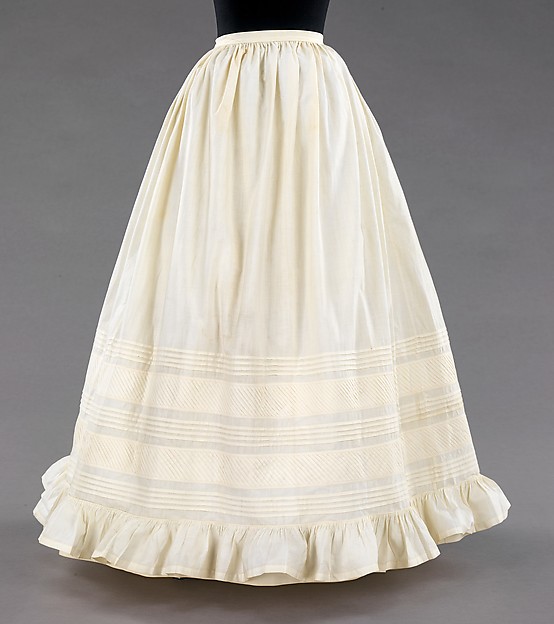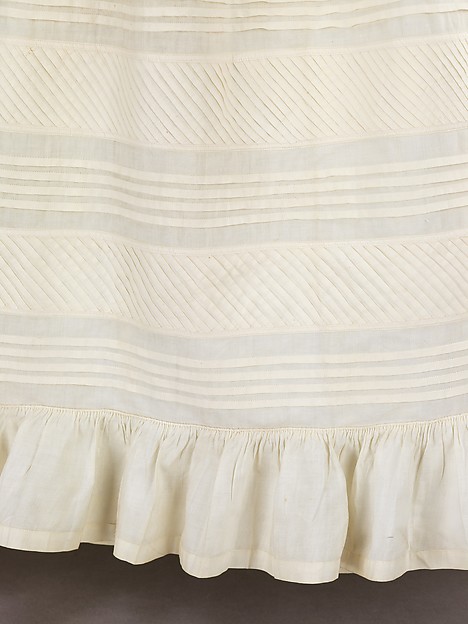 |
| Some wrinkling occurred while travelling across the country. |
 |
| A closer look at those tucks. |
It's four panels of 44" wide pima cotton broadcloth, which gives a nice full petticoat for wearing either over hoops or over my pile of 1850s pettis.
The decoration is based on this 1850s original from The Met:
 |
| Cotton petticoat, c. 1850-60. |
 |
| Tucked detail on the original. |
Height of ruffle: 2.5"
Ruffle hem: 3/8"
Hem of petticoat: Greater than 9/16" (1.5 ruffle-hem-depths) but less than 2.5" (total ruffle depth), based on the solid, whiter shadow which shows under the ruffle where it stands out, which does not extend above the cord.
Fullness of ruffle: The gathers below the cord are neat, regular, and fairly compact. Without measuring the skirt and ruffle hems I can't know the ratio, but I suspect the ruffle is around 1.5x the petticoat width.
Cord diameter: Less than 1/16" width, looks closer to 1/32" (scaled to ruffle hem depth, at highest magnification).
Distance from ruffle top to first tuck: 1/2"
Width of tuck: 1/4"
Distance between tucks: 1/4"
Distance from top tuck to insertion band: 1/2"
Width of insertion border: 1/4"
Width of insertion between borders: 2.5"
Total insertion width: 3"
Width of diagonal tuck in insertion: 1/4"
Space between diagonal tucks in insertion: about 1/16" (three tucks and the space to the right of each takes up approximately 1"). In some places, this spacing increases to 1/8".
Distance between insertion and next horizontal tuck: 1/2"
Waistband width: 1"
Material overlap in waistband (shadows through): about 3/8"
Waist material controlled with gathers.
Machine top-stitching through tucks and on the insertion edge-bands measures approximately 16-18 stitches per inch.
The width of the petticoat at the hem is not given. The shadow-through of a seam on the right side of the picture suggests that the seam allowances are approximately the same width at the horizontal tucks (1/4"). Interior seam treatments at not visible.
For my petticoat, I ended up reducing the tucked design elements from 5 to 3 (I miscalculated the yardage, and ended up about 20" short on the second diagonal band). Though I did make a ruffle, I decided not to add it to the skirt, as I didn't think it looked well with the smaller number of tucks--and, honestly, I don't care for it much on the original, either. The fullness is controlled with stroked gathers at the waist, and fastens with a bone button.
It ended up winning both the faculty and popular ballots in the Needleworker's (open) division of the contest. My thanks to the judges and everyone who voted. :)
Width of insertion between borders: 2.5"
Total insertion width: 3"
Width of diagonal tuck in insertion: 1/4"
Space between diagonal tucks in insertion: about 1/16" (three tucks and the space to the right of each takes up approximately 1"). In some places, this spacing increases to 1/8".
Distance between insertion and next horizontal tuck: 1/2"
Waistband width: 1"
Material overlap in waistband (shadows through): about 3/8"
Waist material controlled with gathers.
Machine top-stitching through tucks and on the insertion edge-bands measures approximately 16-18 stitches per inch.
The width of the petticoat at the hem is not given. The shadow-through of a seam on the right side of the picture suggests that the seam allowances are approximately the same width at the horizontal tucks (1/4"). Interior seam treatments at not visible.
For my petticoat, I ended up reducing the tucked design elements from 5 to 3 (I miscalculated the yardage, and ended up about 20" short on the second diagonal band). Though I did make a ruffle, I decided not to add it to the skirt, as I didn't think it looked well with the smaller number of tucks--and, honestly, I don't care for it much on the original, either. The fullness is controlled with stroked gathers at the waist, and fastens with a bone button.
It ended up winning both the faculty and popular ballots in the Needleworker's (open) division of the contest. My thanks to the judges and everyone who voted. :)
You did such a beautiful job reproducing this petticoat! It must have taken ages to sew all of those tucks but it looks fabulous!
ReplyDeleteThanks! There were a few rather long evenings involved in the tucks.
Delete